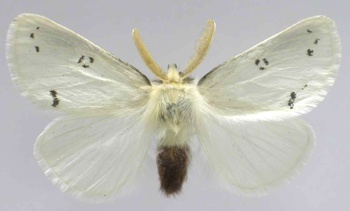Pests
Euproctis chrysorrhoea Linnaeus - Browntail Moth.
Systematic position.
Class Insecta, order Lepidoptera, family Lymantriidae (=Liparidae, Orgyidae), genus Euproctis.Synonyms.
Porthesia chrysorrhoea L., Nygmia phaeorrhoea L.Biological group.
Polyphagous pest of fruit crops and deciduous forest trees.Morphology and biology.
Wingspan of moths is 30-40 mm. Head, thorax, and abdomen snow-white with silky shimmer. Apex of abdomen covered with golden (females) or brown (males) hairs. Moth flight occurs from mid-June until August. Fertility reaches 380-460 eggs on average, 642 maximum. Females lay eggs beginning in the second half of July in batches of 200-500 or more on the lower surface of leaves; the batches resemble small pillows and are covered with golden abdominal hairs. Caterpillars are grayish-black with warts, covered with yellow-brown hairs. Along body there are two red-brown dorsal and white lateral stripes. 9th and 10th segments have one bright red wart. Caterpillars live in colonies. One nest has 200-300, sometimes up to 2000 caterpillars. They skeletonize the upper sides of leaves; later they start to form winter nests together. Diapausing caterpillars of 2nd-3rd instars usually winter in nests of leaves, which are densely bound with web. Caterpillars abandon their nests in spring during bud blossoming of fruit trees. In the beginning, they eat in the afternoon, gnawing buds, sometimes completely destroying them, and disappear into their refuges at night. As daytime temperatures increase to 14-16?C, they finally abandon nests and gnaw leaves, leaving only the central veins. In 30-50 days, the caterpillars pupate one by one or in groups, doing so most often in the lower part of tree crowns, on trunks, and in forks of branches.Distribution.
Lives in Central and Southern Europe, Asia Minor, Northern Africa, North America (introduced), the Baltic States, Byelorussia, Ukraine, Transcaucasia, Moldova, and Northwest Kazakhstan. In Russia, the Browntail Moth foci are distributed throughout the entire European region (northward to Luga and Perm) and the Northern Caucasus.Ecology.
Everywhere monovoltine. Spring reactivation is one of the critical developmental periods for caterpillars, during which temperatures of -2 to 10°C are optimal. Caterpillars require light and heat; therefore, they make nests on the periphery of tree crowns where it is sunny. Short though heavy rains are favorable for their exit from the nests. A temperature decrease during spring and summer of 2°C below normal causes caterpillars to die. It has been experimentally found that temperatures of 17-22°C and a relative air humidity of 40-75% are optimal for caterpillars. development. With a lack of food sources, the older caterpillars are able to migrate up to a distance of 1 km. They endure starvation and are able to live without food for 20-30 days. The lower threshold of cold resistance of caterpillars during the winter period is -40°C. Natural habitats for the pest are in sunny thickets of sloe, hawthorn, and dog-rose in steppes, as well as young oak forests with scattered trees. From here, the Browntail Moth migrates to nearby gardens. Progressive development of the foci is caused by an increase in pupae weight; prevalence of females; increased fertility; and a decrease of parasitoids, predators, and diseases.Economic significance.
Polyphagous caterpillars damage rosaceous fruits, such as apple, pear, cherry, sweet cherry, plum, quince, apricot etc., and also deciduous forest species, such as chestnut, willow, maple, poplar etc., frequently preferring oak and linden. Control measures include cutting and burning branches that bear winter nests after defoliation and insecticide spraying in spring during bud blossoming in orchards.Related references.
Kozhanchikov V.V. 1950. Orgyidae. In: Pavlovskii E.N. & Shtakel.berg A.A., eds. Fauna of the USSR. Lepidoptera. V.12. Moscow & Leningrad: AN SSSR, 581 p. (in Russian).Kuznetsov V.I. 1999. Lymantriidae (Liparidae, Orgyidae). In: Kuznetsov V.I., ed. Insects and mites - pests of agricultural plants. V. 3(2). Lepidoptera. St.Petersburg: Nauka: 279-320 (in Russian).
Nekrutenko Yu.P. 1974. Lymantriidae. In: Vasil.ev V.P., ed. Pests of agricultural crops and forest plantations. V.2. Arthropods. Kiev: Urozhai: 357-361 (in Russian).
Vasil.ev V.P., Livshits I.Z. 1984. Pests of fruit crops. Moscow: Kolos, 399 pp. (In Russian)


